› Forums › Our Collection › News from Amache – Colorado’s Japanese Concentration Camp
- This topic has 0 replies, 1 voice, and was last updated 2 years, 3 months ago by
Regan.
- Post
-
“This is a country of freak weather and anything can happen here”
By Michael Peever: Published on June 9, 2021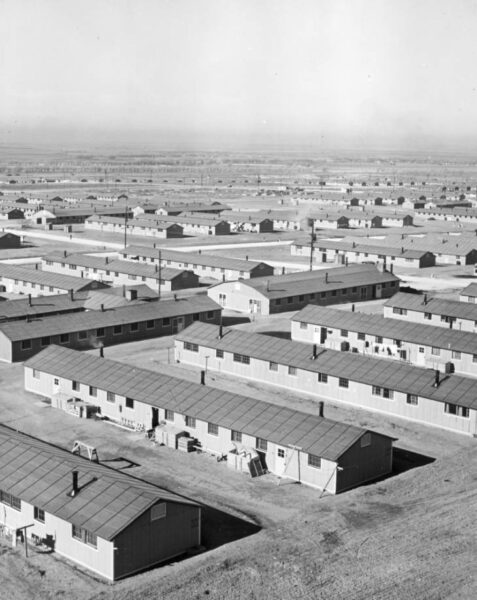
Camp Amache, also known as the Granada War Relocation Center, was a Japanese concentration camp located in Granada, Colorado from 1942-45.
Japanese people had long faced prejudice from whites in the US, but this intensified into a deeply distrustful paranoia after the attack on Pearl Harbor on December 7, 1941, and the United States’ subsequent entrance into World War Two. On February 19, 1942, President Roosevelt signed into law Executive Order 9066 allowing for the creation of military zones (i.e., detention camps) that would provide “every possible protection against espionage and against sabotage.” Japanese people, many of whom were US citizens, were held in camps in the Western US. One such camp was Camp Amache, which housed as many as 7,318 prisoners.
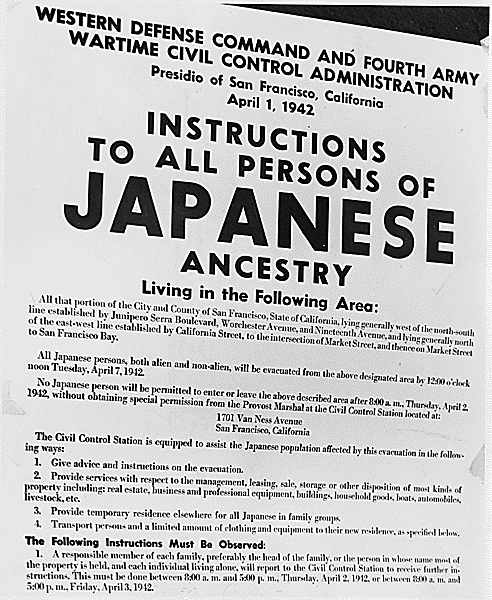
Evacuation orders for “all persons of Japanese ancestry” from April 1, 1942. Courtesy of Wikimedia
The Colorado Historic Newspapers Collection (CHNC) includes no less than six publications from this time and place:
- Granada Pioneer
- The Granada Christian Church News
- Amache Hi It
- Junior Pioneer
- Granada Bulletin
- Pulse
Taken together, these newspapers and newsletters give a remarkable snapshot of life in the camp.
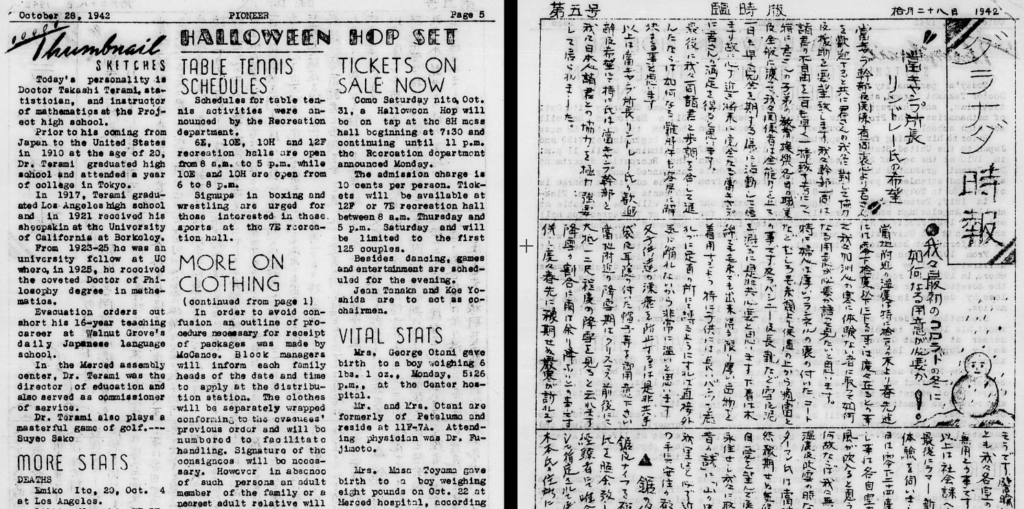
The Granada Pioneer, Amache Hi It, and the Granada Bulletin were written in both English and Japanese. – Granada Pioneer, Volume I, Number 1, October 28, 1942.
Granada Pioneer (as the newspaper was named by one prisoner) was the most important and long-running of the publications. It ran from October 28, 1942 – September 15, 1945 and had a total of 304 issues. An essential source of camp news, information, and resources, it covered many aspects of life at the camp, from birth and death statistics, to calls for volunteers, camp scandals, and even short profiles on prisoners.
In the debut October 28, 1942 edition, Amache director James G. Lindley wrote:
On behalf of the national, regional, and local staffs of the War Relocation authority, I extend greetings and welcome to all residents of the Granada relocation center. We wish to make this an outstanding project, a good place to be, a good place to live, and a place that we can look back upon with pleasant memories. The past has been a period of adjustment, many things have not been as they should; the present finds us still short of proper living conditions; but we are working many hours every day to speed up improvements…
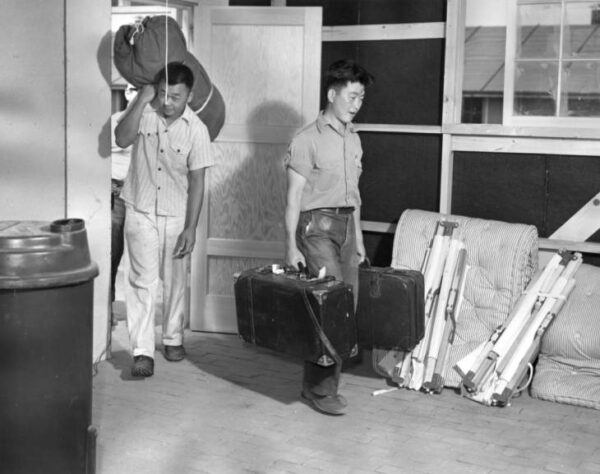
Newly arrived prisoners carrying their personal belongings into their new quarters at Amache – August 28, 1942 – courtesy of Denver Public Library
In the same issue, mindful of the fact that many prisoners previously lived in more reliably warm climates like California, “residents” were advised that low temperatures were forecasted and how to dress for the Colorado winter.
Flannel-lined coats of the heavier type are recommended, especially for women. Overshoes and galoshes are an absolute necessity and long underwear, a rarity in California, is recommended. Heavy snowfalls begin about Christmastime and cold weather will continue till early spring. The average snowfall is one to two feet deep. The custom here is to wear winter woollies until Easter. Parents are advised to dress children in long woolen trousers, which can be tied at the ankles to keep the heat in, and ear muffs, mittens, and caps must not be overlooked.
The article closes with a sentiment that everyone who has lived in Colorado knows in their bones:
This is a country of freak weather and anything can happen here
Also of note in the Granada Pioneer newspaper was the running comic strip Lil Neebo. This cartoon was created by Japanese American animation artist Chris Ishii who had once worked on the Disney films Fantasia and Dumbo. Ishii was transferred to Amache from the Santa Anita camp in California, before joining the US Army in 1943.
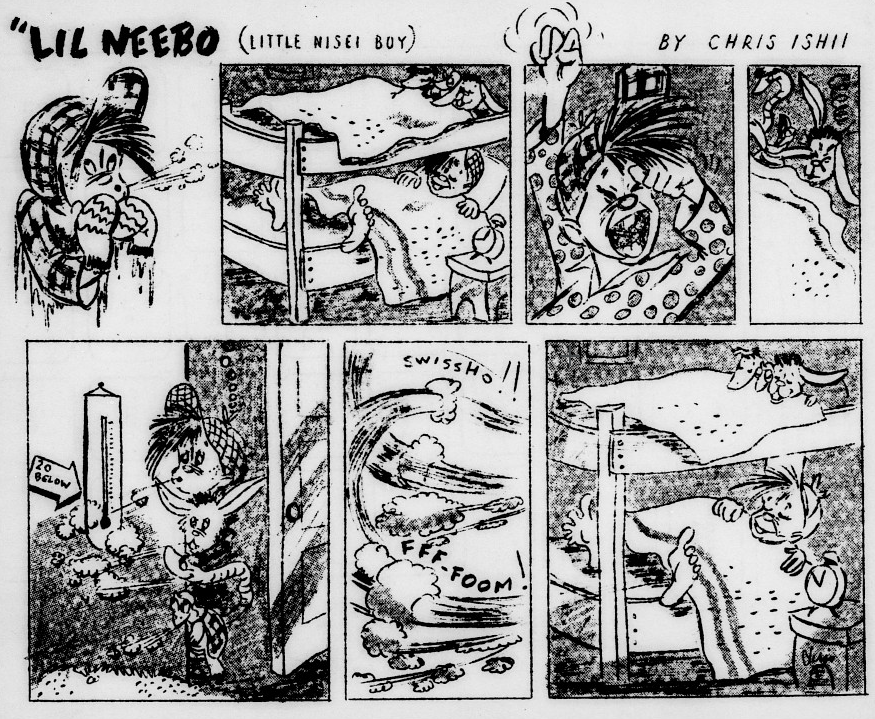
Little Nisei Boy and friends feeling the cold. The name Neebo is a contraction of “Nisei” – meaning a person born in the US or Canada whose parents were immigrants from Japan – and “boy.” The regular cartoon depicts Lil Neebo and life in the Amache camp. Granada Pioneer, Volume I, Number 3, November 4, 1942
Amache was a microcosm, secured by barb wire and guard towers, with its own hospital, dentist, post office, police and fire departments, a new high school, and even a print screen shop which would churn out large numbers of posters for the US Navy.
While agriculture employed the majority of labor in the camps, adults worked in other capacities as well. Sixty served in the Amache police department and three crews of firefighters supported daily operations. Inmates worked as teachers (alongside Caucasians), medical personnel in the hospital, dental staff, mess hall cooks, postal employees, librarians, and in the co-op. (amache.org)
While Amache grew to be self sufficient in many ways, it was not cut off from the outside world, and interactions between prisoners and locals were a commonplace occurrence in daily life. For example, Amache had a formidable football team and would often play nearby teams. The ‘Letters to the Editor’ Section is an interesting glimpse into small details of camp life.
Why can’t something be done about the clothes-line hung from barrack to barrack? It is not only an ugly sight but is dangerous to the public as well. There has been a case of a boy injuring himself seriously just because he did not see the clothes-line. True, the people should watch where they are going but it is quite impossible to see the lines at night, especially if one is in another block. In the interest of the people’s behalf, I remain, MARGARET.
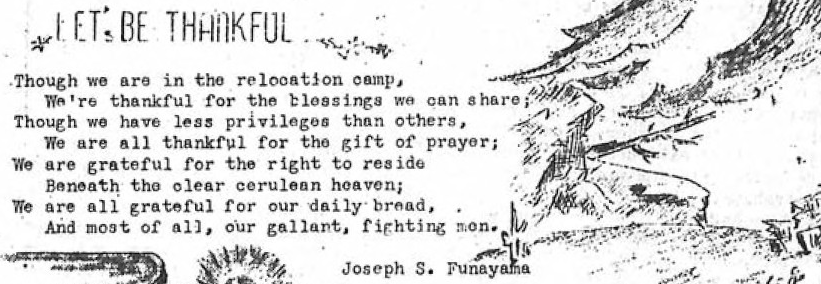
‘Let’s Be Thankful’ – Pulse, May 15, 1943
One intriguing letter from the Four Vagabonds is full of praises for the inmate-run newspaper:
We, the Four Vagabonds, wish to send our orchids to you and your fine staff, in publishing what we sincerely believe, is the highest class camp paper in the United States. We have been receiving each copy with a great feeling of happiness. It tells us clear and plain what goes on in the camp we left behind, to help Uncle Sam win this war through food production on the farm. We assure you, that we and hundreds of other nisei are sincere in their belief, in that thru the use of their young strong physical bodies, food production will be on the increase from now on for the boys overseas— Keep up the good work and lots of luck and happiness to a great paper and news staff. FOUR VAGABONDS KEENESBURG, COLO.
Although we shouldn’t jump to conclusions that life at Amache was in any way “happy” – we are after all talking about the exact definition of a concentration camp – some inmates seemed eager to prove themselves loyal to the country that had stripped them of their rights, as shown in the article, EVACUEES AID FARMERS: Volunteers Harvest Beets.
In answer to the pleas of local beet farmers, who were threatened with a loss of 60,000 tons, the assembly voted unanimously to come to the aid of farmer neighbors. Already 141 volunteers including 20 high school students and five women have rallied in this nationwide crop-saving campaign.
By the end of 1944, Executive Order 9066 was suspended and the Supreme Court issued rulings that barred the government from detaining citizens who were “concededly loyal” to the country, albeit while refraining to rule the relocation program unconstitutional. Japanese Americans were free to return home, but for many people their lives had been destroyed. Anti-Japanese sentiment (and anti-Asian sentiment in general) did not magically disappear, and indeed continues to this day. Professionals lost their practices and many people effectively had to start from scratch – some had no home to return to as they had been forced to sell their assets when evacuation was imminent. The lasting impact of “internment”* is unmeasurable and it wasn’t until 1988 that incarcerated individuals received some reparations.
A supplement to the Pioneer called Pulse appeared on May 15, 1943. This small publication contained the creative writing of Amache inmates. Take for example the poignant poem ‘I Still Love You, My America,‘ by Shozi Oniki, which typifies the strength – as well as the pain – of a people so wronged:
America, this is my homeland,
I know no country, but you.
You gave me my education:
An equal chance in the battle of life.
You taught me to believe in the right for
life, liberty, and the pursuit of happiness.
So when they ironically ask, do you believe?
I proudly answer, my head held high;
I am an American.
Then came the memorable December the Seventh.
Because of the blood that flows in my veins;
people were forsaken and shunned,
Discriminated, they were put into camps.
Oh, how my heart was sore with grief;
For my America had lost a chance to
prove herself to the world.
Today, forsaken, discriminated, trampled, and shaken,
I still believe in you, my America.
My America is far greater, more beautiful,
the living dream of our forefathers.
Perhaps, that America is dead for some;
But for me, it is living underneath in the
hearts of true Americans
So no matter how hard the test,
The suffering I may endure;
My destiny is forever linked with yours.
I still love you, my America.
*
Sources
Colorado Historic Newspapers Collection
Photos courtesy of Denver Public Library
Amache.org was an invaluable resource
National Geographic*Internment is considered euphemistic and there is an ongoing debate about appropriate terms.
-
This topic was modified 2 years, 3 months ago by
Regan.
-
This topic was modified 2 years, 3 months ago by
Regan.
-
This topic was modified 2 years, 3 months ago by
Regan.
-
This topic was modified 2 years, 3 months ago by
Regan.
-
This topic was modified 2 years, 3 months ago by
Regan.
-
This topic was modified 2 years, 3 months ago by
Regan.
-
This topic was modified 2 years, 3 months ago by
Regan.
-
This topic was modified 2 years, 3 months ago by
Regan.
-
This topic was modified 2 years, 3 months ago by
Regan.
-
This topic was modified 2 years, 3 months ago by
Regan.
-
This topic was modified 2 years, 3 months ago by
Regan.
-
This topic was modified 11 months, 1 week ago by
Babi Hammond.
-
This topic was modified 11 months, 1 week ago by
Babi Hammond.
- You must be logged in to reply to this topic.